Choquei, Parente (in English, “What a shock, relative” – the “relative” explained below) is today’s hottest source of indigenous-related gossip. The platform’s Instagram bio says it all: gossip, memes and the indigenous fight. The page is inspired by a better known social media channel, Choquei, which deals in gossip about the more conventionally famous, most of whom are white. Choquei, Parente, meanwhile, is the page of famous indigenous people, of “ancestral celebrities” or “influencer relatives”. And if you aren’t here in the Brazil of 2023, I should explain that “parente”, or relative, is the word the current generation of indigenous Brazilians use to refer to others they recognize as indigenous. Everyone is a parente, unless they aren’t.
And indigenous gossip has taken over politics. I take a deep breath and laugh loudly, followed by tears of relief. We survived the genocidal government of Jair Bolsonaro and I’m alive, laughing, remembering my indigenous friends who also managed to stay alive, to take on the most important roles in government in Brasília. And I can even write about a page of indigenous humor, and the indigenous fight. Hello, 2023!
I’ve worked with Brazil’s indigenous peoples since January 2013. And we’ve been lacking a source of humor in this new Brazilian indigenous political context. Did you know that Choquei, Parente is full of good gossip? The kind that can explain the bullshit – who fought with who, who kissed who, who cheated on who –, make you laugh and which you can forward on to a curious friend. And it speaks through memes. For good or ill, this is how a large number of Brazilians, indigenous or otherwise, keep themselves informed. Choquei, Parente is put together by indigenous people who prefer to remain anonymous, and has become a sensation among the parentes, or the relatives, in Brasília.
Why am I telling you all this? Because in the final days of 2022 the stories on Choquei, Parente were blowing up. There was poll after poll to choose the indigenous Brazilians of the year – the best filmmaker, stylist, model, actor, singer, activist, influencer, leader, youth leader, and LGBTQIA+ symbol. And in the midst of these disputes, there were also fan polls about whether Brazilian president Luiz Inácio Lula da Silva, commonly known as Lula, would fulfill the promise he made during his visit to the last Acampamento Terra Livre (Free Land Camp, in English), an annual mobilization which has been held in Brasília for the last 18 years. There, Lula, at the time a presidential candidate, promised to create a ministry for indigenous peoples, headed by an indigenous person.
Polls, memes and controversial statements fan the flames after Lula’s victory:
One of the memes on the Choquei, Parente timeline shows a Twitter comment by the writer Daniel Munduruku: “I believe the indigenous movement has shot itself in the foot by nominating @GuajajaraSonia as minister,” it reads. “Indigenous Brazil would gain more from having her combative style in Congress. But either way, I’ll be cheering for her success. That said, I’d prefer @JoeniaWapichana”.
Ailton Krenak, Davi Kopenawa and Raoni Metuktire also announced their support for Joênia, who, as a candidate for the Sustainability Network party in the state of Roraima, was not re-elected to Brazil’s national congress in the recent elections. The Coordination of Indigenous Organizations of the Brazilian Amazon, the largest indigenous organization in the Amazon, declared its backing for Brazil’s first indigenous lawyer. The largest indigenous organization in the south of the country, the Southern Articulation of Indigenous Peoples, also published a statement calling for Joênia to be made minister, yet the comments on the Choquei, Parente page and the polls on the platform’s Instagram “stories” showed that Sonia Guajajara, of the Socialism and Liberty party, recently elected to congress after winning more than 150,000 votes in the state of São Paulo, had both her own strength, and the support of the gossipmongers, behind her.
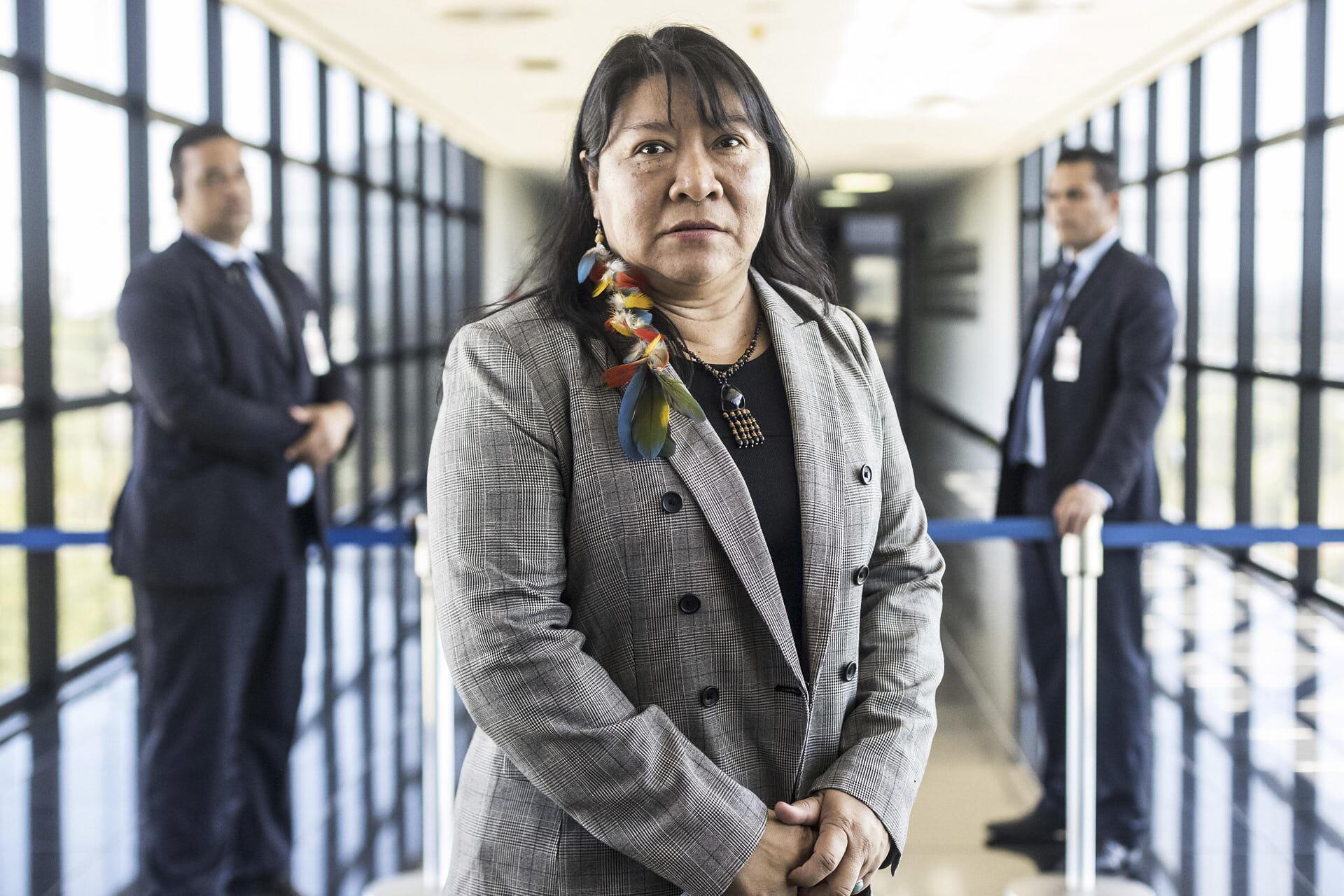
Joênia Wapichana, ex-deputada federal, primeira indígena a advogar no Brasil e recém-nomeada presidenta da agora rebatizada Fundação Nacional dos Povos Indígenas (Funai). Foto: Mídia Ninja
Lula could have announced his choices to lead the ministries of the Environment and the Indigenous Peoples at COP27 in November last year, but chose not to, leaving room for Joênia’s name to be put forward – despite all the signs suggesting Sonia was the favorite. Not least because Joênia is from the Sustainability Network, the same party as Marina Silva and Randolfe Rodrigues, who at the time were strongly tipped to lead ministries – and it was unlikely there would be space for three ministers from such a small party. In the end, Randolfe, Lula’s campaign coordinator, was made leader of the government in Congress, while Marina was confirmed as Minister for the Environment.
With the delay, planned or otherwise, Lula created both awkwardness and an unnecessary climate of rivalry in a movement which, in a notably unified manner, had supported him during his campaign. I lived in Altamira between 2013 and 2015, when Dilma Rousseff was Brazilian president, and witnessed how her Workers’ Party governments used the rupturing of social movements as a strategy to force through the construction of the Belo Monte Hydroelectric Power Plant. It’s hard not to feel a chill when watching the same party, once again, through negligence or carelessness, stirring up rivalries between Brazil’s two main indigenous leaders, especially at this highly sensitive moment, when the indigenous movement will, for the first time, put both its feet under the table of central government.
Away from Choquei, Parente, tempers in the indigenous movement ran high. The diplomatic solution came from the Articulation of Indigenous Peoples of Brazil, which gathered together its leaders and sent Lula a list of three nominees for the role of minister: Sonia Guajajara, Joênia Wapichana and Weibe Tabeba.
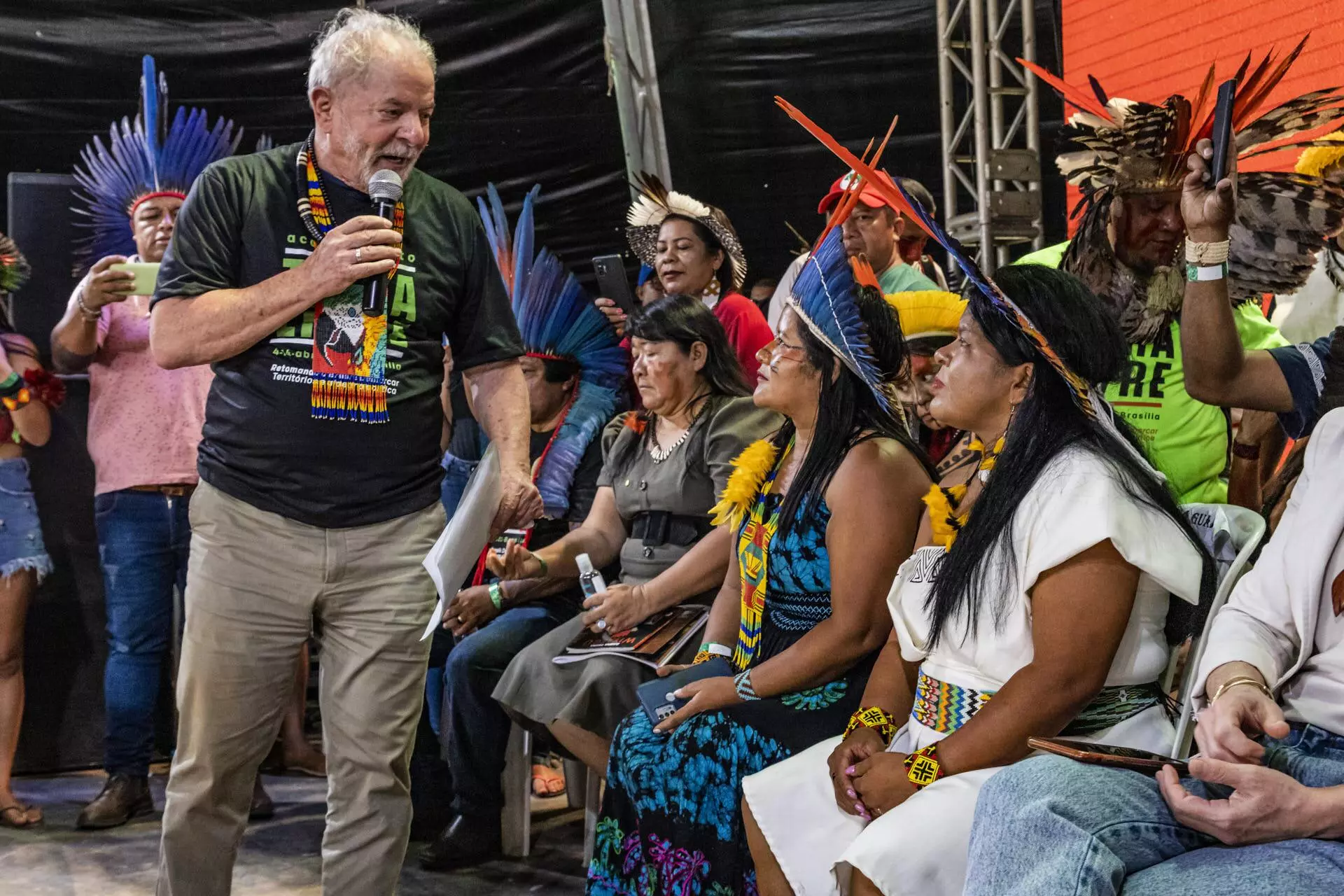
Lula ainda não era presidente quando falou pela primeira vez de um Ministério dos Povos Indígenas. Foi no Acampamento Terra Livre (ATL), em Brasília, em abril de 2022. Joênia Wapichana e Sonia Guajajara estavam na plateia. Foto: Mídia Ninja
Those who witnessed Lula talk about the groundbreaking new ministry for the first time, at the Acampamento Terra Livre in April last year, had little doubt that, if it came to pass, it would be led by Sonia. It was at the camp – the first live edition in three years, after the 2020 and 2021 events were held online due to the Coronavirus pandemic that killed so many indigenous elders – that Lula had the idea. And when he did, he was looking straight at Sonia.
The return of the mobilization was important. I remember how many people, from fear of police violence from the Bolsonaro government and the pandemic, argued that it shouldn’t take place. But Brazil’s indigenous women (and even men) organized a huge global women’s march, and a camp of more than 5,000 people, without any injuries or arrests, and garnered significant international attention.
On that day in April, Lula had a breakfast meeting with a number of indigenous leaders, and went to speak at the camp in the afternoon. On stage, before speaking himself, Lula listened to the speeches of several indigenous election candidates. Sonia Guajajara was the last of them – and spoke for 11 minutes.
“We are here to show Brazil and the world that we’re taking it back. The theme of the camp is to take back Brazil, demarcate territories and indigenize politics. Because for only one of 513 members of Congress to be an indigenous woman [Joênia Wapichana] is no longer good enough.
We want someone to take back our participation in the spaces of social control, where Brazil’s government policies are constructed. We want the indigenous health secretariat strengthened. We can no longer bear to see children sucked into the dredgers of illegal mining.
We don’t just want to be involved when you win, we want to start participating in the project to build a new Brazil now.
That’s why we’ve decided to launch an indigenous lobby in 2022. It’s a cocar (headdress) lobby, an indigenous lobby, which will oust the rural landowner lobby once and for all.”
While it can’t be seen on the videos that circulated on the internet, at that exact moment, the Kayapó indigenous people had their arms crossed, and were glaring at Sonia. That’s when she started talking about the Xingu River.
“We’re here to make sure there won’t be another Belo Monte under your government, President Lula. We don’t need more Belo Montes.”
Lula, who was wearing a huge, beaded necklace with a macaw on it, watched Sonia closely, and appeared to nod his head in agreement..
Sonia continues: “We don’t need Belo Sun, which will extract gold from our land.
For a long time we didn’t want to run the Special Department for Indigenous Health, but now we want to. We can’t let these institutions remain under government control. We should take them on, we should.
We also want to take charge of the ministries. We’re capable of taking responsibility for all the indigenous policies of this country.”
Lula smiles. And Sonia goes on.
“That’s why we’re here, with over 30 indigenous candidates. Because we will no longer accept a Brazil without us.”
Sonia embraces Lula.
On the subject of Belo Monte and Belo Sun, Lula answered (while not really answering at all): “No one did more than us.” And he went on: “Now you’ve given me an idea. Look, if we’ve created a Ministry of Racial Equality, if we created a Ministry of Fisheries, why can’t we create a ministry to discuss indigenous issues? Not with a a white man like me or a galega (informal term for a blonde, pale-skinned person) like [Workers’ Party president] Gleisi Hoffmann. It will have to be an Indian man or woman. People will complain, they’ll say: ‘Oh, they’re spending so much money, we need fewer ministries’. Really, what they don’t want is the active participation of society”.
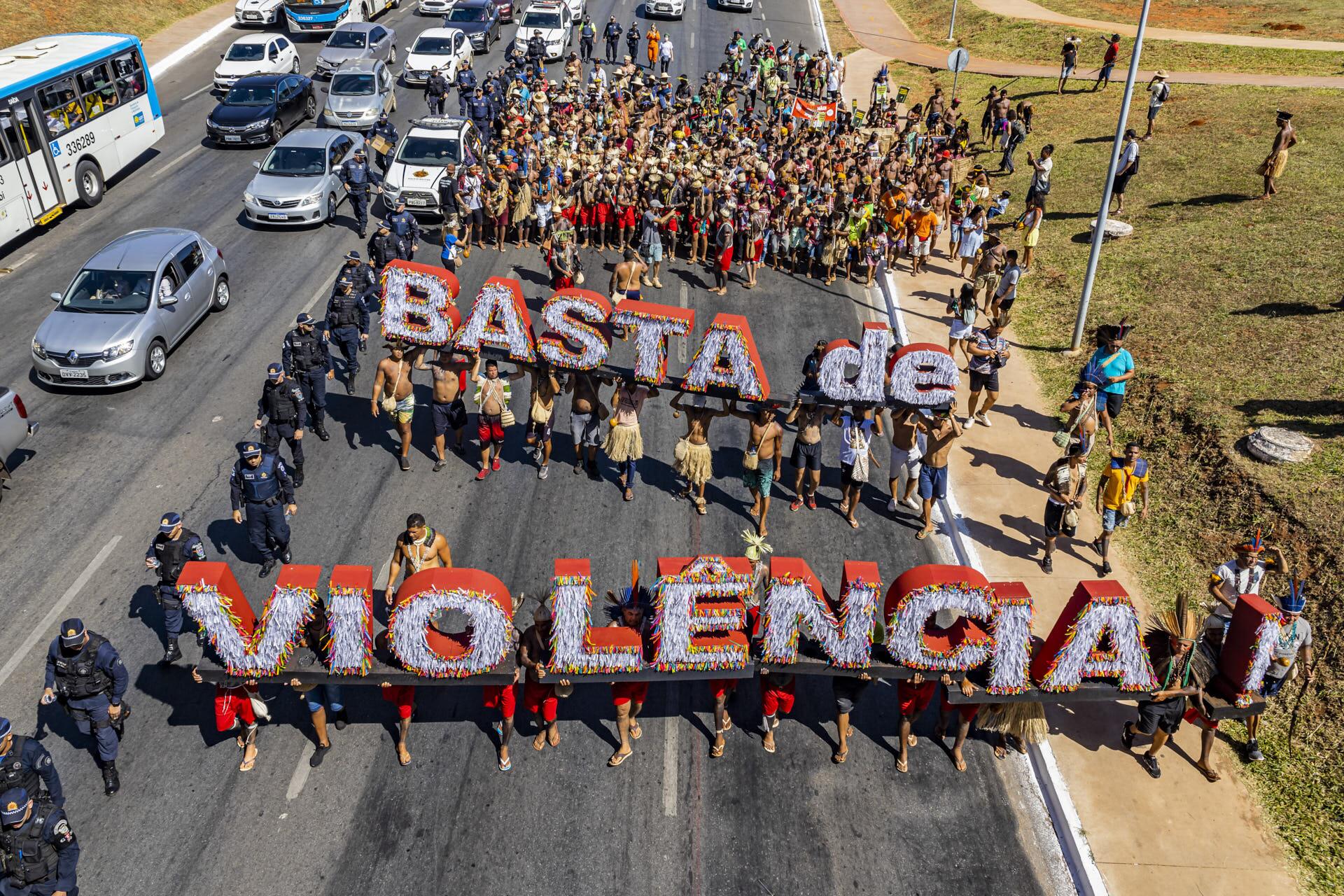
A realização presencial do Acampamento Terra Livre em Brasília em abril de 2022 foi uma retomada importante da mobilização indígena. O ATL promoveu o debate de pautas importantes, protestos pacíficos e teve repercussão internacional
A lot of people commemorated Lula’s speech. And a lot of people were troubled by it. While most indigenous people celebrated enthusiastically on social media, I heard the concerns of indigenists who, in some form or other, contributed to the construction of the framework of indigenous policies. This is because, in the past, Brazil’s federal industry for indigenous affairs was responsible for all indigenous policy. And the 1990s were marked by the fight for decentralization, in health, education, and the protection and demarcation of lands, with their own budgets and policies.
Decentralization began in 1996, under Decree 1775, which regulates the demarcation of Indigenous Territories. Three years later it was the turn of health, when the Indigenous Health Care Subsystem was created through a bill authored by congressman Sérgio Arouca, which became known as the Arouca Law. It states that the subsystem is the responsibility of Brazil’s federal government, and ordered the creation of Special Indigenous Sanitary Districts. In Brazil, today, there are 34 such districts, divided by the geographic occupation of indigenous communities, and not always by state boundaries. The service offers basic indigenous health units, base health centers and indigenous health support houses, where people from indigenous villages can stay while in the city for treatment.
In 2002, the Ministry of Health created the National Policy for Health Care for Indigenous Peoples and, finally, in 2010, the Special Secretariat for Indigenous Health was created, an autonomous organ responsible for indigenous health, with its own budget. This department was given to the third name on the Articulation of Indigenous Peoples of Brazil’s list, Weibe Tapeba, who was nominated by the indigenous of the sea, or in other words, the indigenous of the northeast of Brazil who, historically, have had their disagreements with the indigenous of the Amazon. As a result, they didn’t support either Joênia or Sonia, and ended up with the most important indigenous health secretariat, subordinate to the Brazilian Ministry of Health.
Since the Brazilian president at the time, Fernando Henrique Cardoso, of the Brazilian Social Democracy Party, signed Decree 1775, the ruralist lobby has tried to contest it several times. But Brazil’s Supreme Court ruled the decree was constitutional in 2009, during hearings on the Raposa Serra do Sol Indigenous Territory, making further legal challenges impossible. The law establishes that the demarcation process begins with the National Foundation of Indigenous Peoples, or Funai (recently renamed to replace the word “Indians” with “Indigenous Peoples” in its title), with the formation of a working group of anthropologists, who study the area in question and define the size and shape of the indigenous land required, so that the people or peoples who live there can continue to live according to their customs. If they hunt, for example, they need a hunting area, whereas if they fish, they need to have access to the river or the sea. Areas for crops are required for peoples with agricultural traditions, and demarcation should consider the peoples’ burial sites and sacred places.
When these studies are complete, the Funai president evaluates and signs the detailed report with all the necessary information on the indigenous territory in question. This report is published in the Federal Government Gazette, as well as the official government gazette of the state where the land is located. This is followed by a 90-day period in which the relevant state and municipal authorities, as well as other interested parties, can contest the proposed demarcation, presenting Funai with evidence such as title deeds, expert reports and opinions, witness statements, photographs and maps, in an attempt to obtain compensation or demonstrate flaws in the report, and prevent the process from proceeding.
After this period of 90 days, the Funai president sends the report to the Ministry of Justice, so that the minister signs the declaratory ordinance and sends it to the President of Brazil, who in turn issues a decree recognizing the limits of the indigenous land. After the decree is signed, the indigenous territory can be registered in a notary’s office.
I’m explaining all this so we can understand the division of powers and also the nature of the dispute. The hierarchy in place for the demarcation of a territory is the President of Funai, the Minister of Justice and the President of Brazil. Today, the informal assessment of the Articulation of Indigenous Peoples of Brazil is that there are at least 13 proposed Indigenous Territories with no pending issues sitting in the president’s drawer. The talk among indigenous groups is that these demarcations will be signed by Lula in January, an early demonstration of how Brazil has changed.
What may happen with proposals for other territories, which involve much more complicated disputes for the broad front that elected Lula – and which are at earlier stages of the process – remains unknown.
The provisional measure to create the Ministry of Indigenous Peoples does not make it clear whether the declaratory ordinance, previously established as coming under the responsibility of the Ministry of Justice, will be transferred in full to the Ministry of Indigenous Peoples. Article 42 of this provisional measure, published on New Year’s Day, establishes that the Ministry of Indigenous Peoples is responsible for indigenous policy and the recognition, guarantee and promotion of the rights of indigenous peoples; the recognition, demarcation, defense, exclusive usufruct and management of indigenous lands and territories; the well-being of indigenous peoples, the protection of isolated and recently contacted indigenous peoples; and international agreements and treaties, in particular Convention No. 169 of the International Labor Organization, which, among various guarantees, determines that indigenous populations must be consulted on the use, management and conservation of their territories.
In summary: the entire demarcation structure should be transferred to the new ministry, but it needs to be decided how this will happen. Migration of the process to the Ministry of Indigenous Peoples makes perfect sense, but a number of indigenous leaders and indigenists fear exposing the process to attacks by altering the legal framework and replacing a decree already approved by Brazil’s Supreme Court. Joênia Wapichana, the new president of Funai, recommends prudence. “It is up to the president [Lula] to decide. I believe that [for the time being] Decree 1775 will not change, so the same procedures for demarcating indigenous lands will remain”.
Workers’ Party member of congress Juliana Cardoso, an indigenous woman of the Terena people, agrees: “Demarcation should remain with the Ministry of Justice. It should be looked at with a little more attention and care, because my concern is that any changes we make to a procedure which already has a structure in place, which is only responsible for demarcations, could eventually be used to make the process more difficult”.
There are good reasons to work towards a secure transition. One is that phases of demarcation are frequently subject to legal challenges. When Funai publishes the results of its studies, for example, a farmer might claim that part of the area is his, make a legal challenge, and tie up the process for years. Or the Funai president’s office might finish the study, send it to the Ministry of Justice, and a land grabber might challenge it. In other words, even with a robust legal framework, challenges arise and can prolong processes for years or even decades. The fear is that opening the system up to attack by introducing a new legal framework to supersede a decree that has already been reviewed by the Supreme Court and consolidated through practice, could lead to a flood of legal challenges, delaying even further demarcations that have already been paralyzed by four years of Bolsonarism. There are undemarcated indigenous territories experiencing humanitarian crises, and which urgently need their stalled claims to move forward, and the Constitution to be complied with.
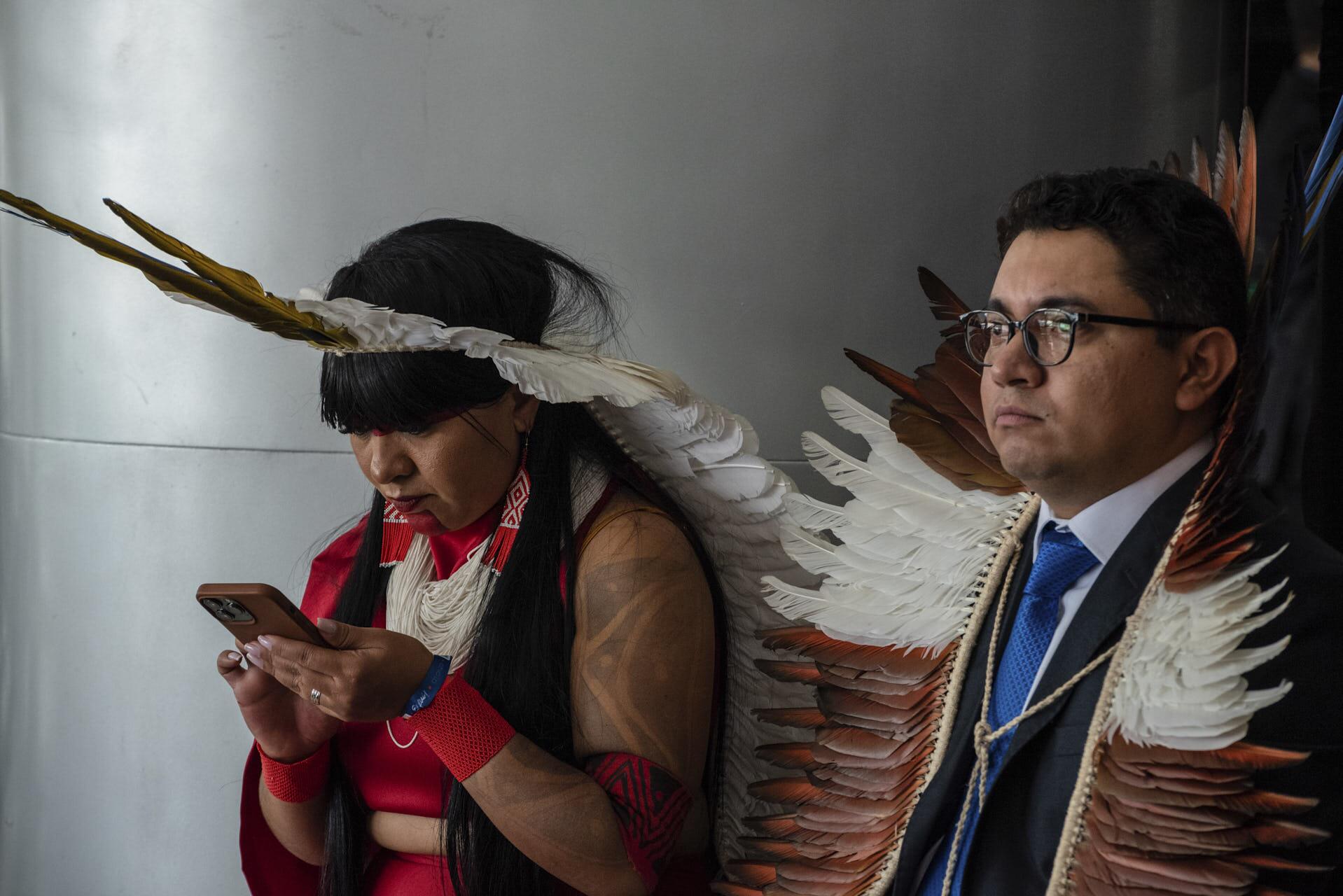
A deputada eleita Célia Xakriabá e o advogado Luiz Eloy Terena na posse do presidente Lula em Brasília. Terena será secretário executivo do Ministério dos Povos Indígenas. Foto: Maíra Erlich/SUMAÚMA
Minister Sonia Guajajara is already getting ready for the battles ahead. For her ministry’s executive secretary she has chosen one of the leading authorities on indigenous rights, Luiz Eloy Terena, a lawyer and postdoctoral fellow at the School of Social Studies in Paris. Responsible for one of the claims of indigenous genocide filed against Bolsonaro at the International Criminal Court, Eloy is used to defending peoples in a variety of demarcation actions, regions and contexts. He is from the state of Mato Grosso do Sul, where large areas of land are in the hands of a few large landowners, and the scene of one of the most brutal examples of the effects of the Brazilian state’s historical omissions regarding demarcation. The state is home to the Guarani Kaiowá ethnic group, the largest indigenous population in Brazil, with around 80,000 people living in situations of violence, abuse and indignity. The Guarani Kaiowá’s struggle has seen a number of their leaders murdered, victims of conflicts with squatters, land grabbers and landowners in the region, a situation aggravated by disastrous judicial decisions.
The signs suggest that Eloy Terena will be trusted by Sonia Guajajara to put together the staff and design the structure of the new ministry. He has led actions brought by the Articulation of Indigenous Peoples in the last four years, such as ADPF (claim of non-compliance with a fundamental precept) 790, the first lawsuit authored by an indigenous organization to be analyzed by Brazil’s Supreme Court, and which introduced compliance with Article 232 of the Brazilian constitution: “Indians, their communities and organizations, are legitimate parties for the filing of lawsuits in defense of their rights and interests, with the public prosecutor’s office intervening in all acts of the process”. Until then, indigenous actions had been signed by political parties or indigenous organizations. It took 32 years, the same age as Eloy, for Brazil to put into practice a legal article that is essential for indigenous peoples.
Eloy has already announced on Twitter that the ministry will have three secretariats and seven departments, one of which will be the department of territorial demarcation. The structure was designed during sessions of the Lula government’s Transition Group, attended by dozens of indigenous people from all over Brazil.
Eloy and Sonia have been working together since the first hour of the first day of the year. The Ministry of Indigenous Peoples is housed on the seventh floor of the Ministry of the Economy building. The new president of Funai and the new Minister of Indigenous Peoples also met every day during the first week of government.
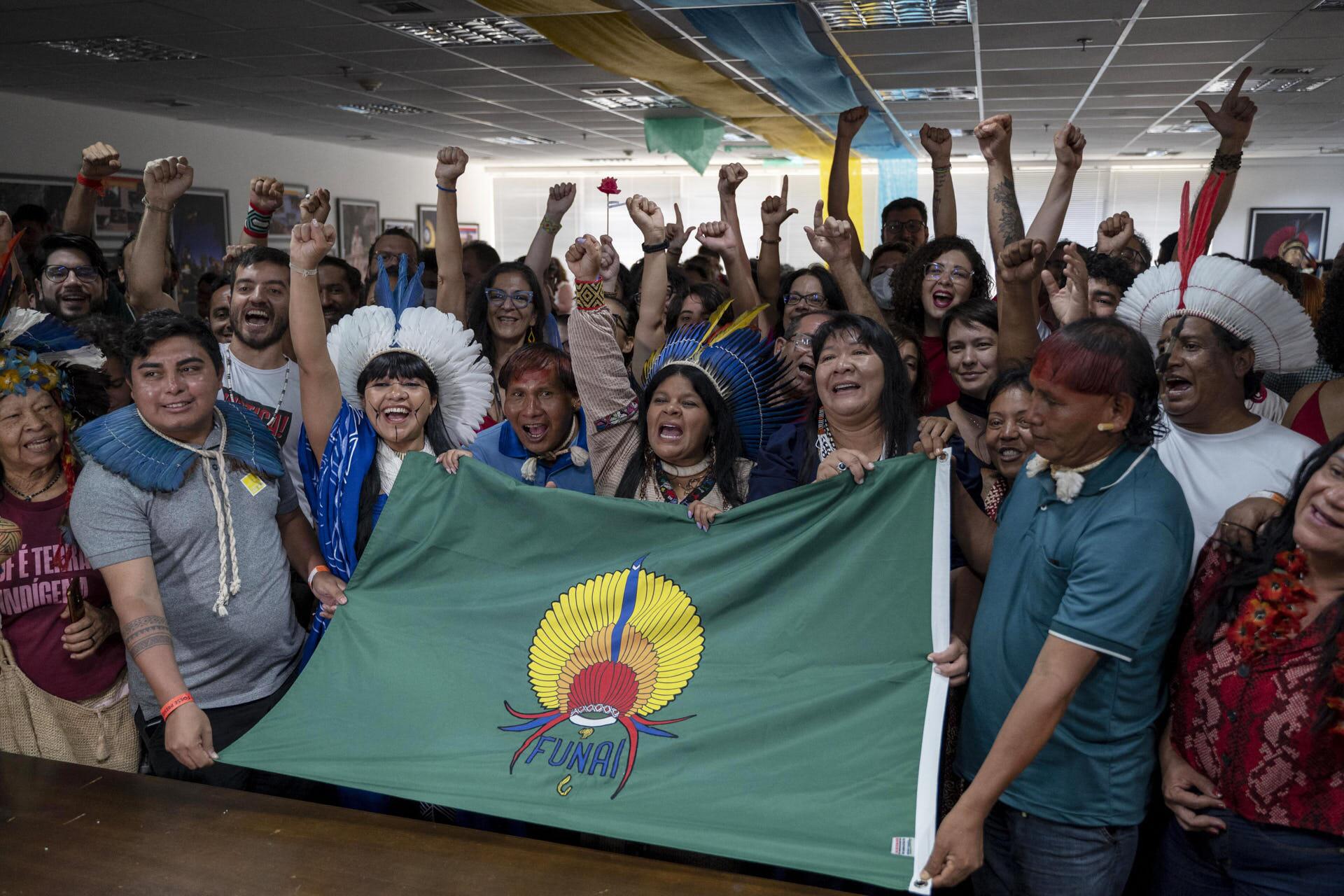
A nova ministra e a nova presidenta: Sonia Guajajara celebra ao lado de Joênia Wapichana o dia histórico da ocupação indígena na Funai. Foto: Mario Pimentel/AFP
Joenia and Sonia have never been best friends, are members of different parties, and are rarely seen smiling together in photos. But indigenous Brazil has advanced in leaps and bounds every time they’ve joined forces over the past four years. One example was when Bolsonaro tried to put Funai under the control of the evangelical pastor Damares Alves, then his government’s Minister of Women, Citizenship and Human Rights. It was largely the joint strength of these two indigenous leaders that kept Funai in the Ministry of Justice. Or when Joênia defended Sonia after she was relentlessly attacked by General Augusto Heleno, head of the Bolsonaro government’s Institutional Security Office, who even said on social networks that he would see Sonia in jail.
At the historic indigenous occupation of Funai on January 2, Sonia sat on Joenia’s right-hand side. She stated: “There were many people who said that the story of Articulation of Indigenous Peoples’ triple nomination, with the names of Weibe, Joênia and me, represented a fissure in the indigenous movement. But the three of us are here at this table occupying the most important strategic spaces of Brazilian indigenous policy”. Joênia reciprocated, saying: “I thank my parentíssima (a name invented by elected congresswoman Célia Xakriabá, meaning “most excellent relative”). I’m only going to call her my parentíssima from now on and we’re going to talk all the time”.
The emotion displayed by Chief Raoni, the figurehead of the Brazilian indigenous movement, and a key figure in the reassuming of control over Funai, seemed to seal the peace, and foreshadow better times. Times when indigenous people speak and civil servants listen, indigenous people decide and civil servants execute their decisions.
I visited the Ministry of Indigenous Peoples building the next day. At the entrance, I met the new Funai president, Joenia Wapichana. Before even greeting me, she started complaining: “I’m outraged by the Funai budget. There isn’t enough money to put a team together. How can I convince an advisor to take on such responsibility on five thousand reais, in Brasilia, where the rent is three or four thousand reais?”
It’s a fair claim, and one shared by many other agencies. Senior Management and Advisory positions, which can be occupied by any employee or person outside the public service, have not been readjusted since 2015, while rents in Brasília have gone up 6% in the last year alone.
For the time being, signs improvised with stickers identify the access doors to the ministry. Many rooms are being renovated. On the ground floor, I found a group of Kayapó and a group of Xavante. Each carried folders of documents and had their demands ready on the tips of their tongues.
Sonia Guajajara spent that day meeting with the delegations that came from all over Brazil to greet the new minister and, of course, to ask for help. The parentíssima takes office on January 11.
Last week, when signing the commencement documentation, she held a pen in one hand and a maracá – a musical instrument that white people call a rattle – in the other. It was not just another ornament. Maracá Emergência Indígena (“Emergency Indigenous Maraca”) was the name of an online festival organized by women in August 2020 to promote actions to combat the pandemic in indigenous territories.
The Bolsonaro government pursued and tried to bring criminal charges against Sonia because of the event. In April 2021, she was summoned by the Federal Police to testify for committing slander and defamation and spreading fake news against the now former president. Now, in 2023, Maracá has been turned into a documentary, and is available to watch, Sonia is Minister of Indigenous Peoples and signs the documents with a maracá in her hand. It is not an insignificant moment. On the first day of the year, her party, the Socialism and Liberty Party, requested Bolsonaro’s preventive arrest for the dissemination of fake news about Brazil’s electronic voting machines, and his support for actions demanding a coup. The charge is currently with Brazil’s Supreme Court.
There are those who claim Sonia is merely a celebrity and not a leader, due to the level of support she receives from artists and the famous. Everyone from Leonardo DiCaprio to Brazilian YouTuber Felipe Neto, legendary singer songwriter Caetano Veloso and drag queen Pabllo Vittar supported her congressional bid. Sonia is unperturbed, and in red lipstick and high heels, continues to appear firm and serene. She knows that politics will always try to disqualify, delegitimize, manipulate and disrupt women, in an attempt to get them to shut up, shrink, submit or withdraw.
Sonia knows where her roots lie. When Raoni met her in a hotel before walking up the ramp with President Lula, he took her face in his hands and said: “I learned to be angry from you”. Whenever she goes in Brasilia, she is received with a warm “Olé, Olé, Olé, Olá, Sonia, Sooooonia”.
On January 11, Minister Sonia Guajajara will take office. Choquei, Parente!
Translated by James Young





